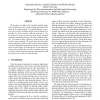Free Online Productivity Tools
i2Speak
i2Symbol
i2OCR
iTex2Img
iWeb2Print
iWeb2Shot
i2Type
iPdf2Split
iPdf2Merge
i2Bopomofo
i2Arabic
i2Style
i2Image
i2PDF
iLatex2Rtf
Sci2ools
AVSS
2003
IEEE
2003
IEEE
Combined Wavelet Domain and Temporal Video Denoising
We develop a new filter which combines spatially adaptive noise filtering in the wavelet domain and temporal filtering in the signal domain. For spatial filtering, we propose a new wavelet shrinkage method, which estimates how probable it is that a wavelet coefficient represents a "signal of interest" given its value, given the locally averaged coefficient magnitude and given the global subband statistics. The temporal filter combines a motion detector and recursive time-averaging. The results show that this combination outperforms single resolution spatio-temporal filters in terms of quantitative performance measures as well as in terms of visual quality. Even though our current implementation of the new filter does not allow real-time processing, we believe that its optimized software implementation could be used for real- or near real-time filtering.
| Added | 23 Aug 2010 |
| Updated | 23 Aug 2010 |
| Type | Conference |
| Year | 2003 |
| Where | AVSS |
| Authors | Aleksandra Pizurica, Vladimir Zlokolica, Wilfried Philips |
Comments (0)

